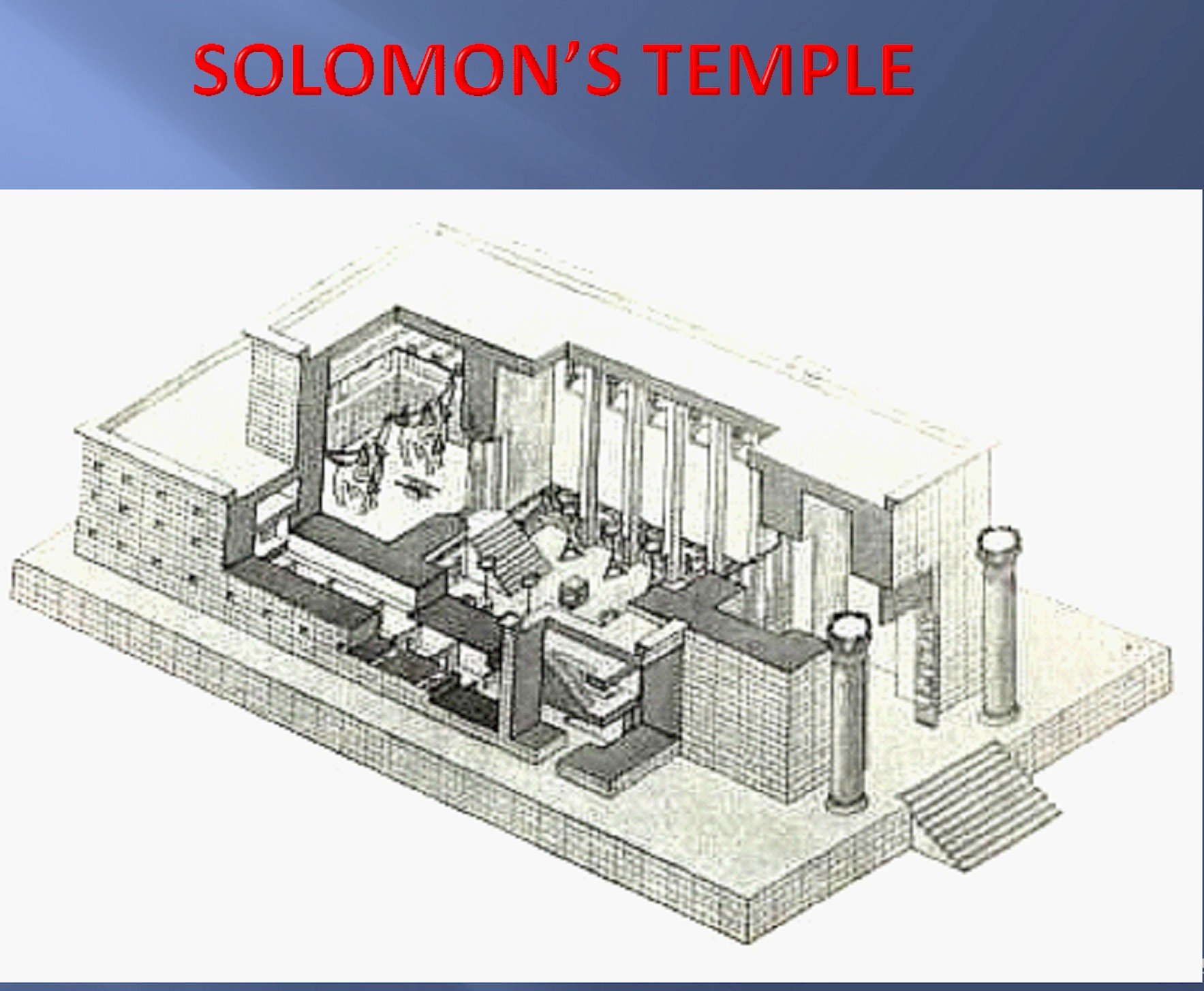CATHEDRAL QUEST
Our quest to experience the great cathedrals and churches of Europe
ROMANESQUE
ARCHITECTURE
1000-1200
(1140)
INTRODUCTION TO CHURCH ARCHITECTURE
The subject of church
architecture occupies volumes and volumes of scholarly and technical writings.
Over the past several years, I have purchased a large number of these
books. My bibliography is available
by clicking –
BIBLIOGRAPHY. My
intention in producing Cathedral Quest is to reveal to my readers the great
adventures that my wife and I have had exploring 133 wonders and creations of
man’s imagination in building edifices to the Glory of God.
My accounts of
Romanesque,
Gothic,
Renaissance, and
Baroque architecture will be rather simple and
basic. For those interested in a
deeper understanding, I would suggest that you read the books I have listed in my
bibliography or countless books available in bookstores, the internet and
libraries.
Human kind has always
been a creation who sought and built places in which to honor and worship their
creator. Victor Hugo (Hunchback of
Notre Dame, 1831) wrote: “During
the first 6,000 years of the world, from the immemorial pagoda of Hindustan to
the Cathedral of Cologne, architecture was the great handwriting of the human
race. Not only every religious
symbol, but every human thought, has its page and its monument in that immense
book. The human race has had
no important ideas that were not written in stone.
Humanity has two books, two testaments: masonry and printing – the
Bible of Stone and the Bible of Paper.”
PREHISTORIC WORSHIP
SITES
A
series of prehistoric finds indicates the existence of ritual cults and
sacrificial ceremonies in the New Stone Age or Neolithic Age (ca.
10,000/8000-4000/1800 B.C. Opinions
differ widely as to whether a form of religion had already developed.
The word “temple” specifically applies to man-made architectural structures
built for the cult of God or the gods as distinguished from the so called high
places, which normally do not consist of buildings of any sort except for an
enclosure around the sacred territory.
Most
ancient temples of Canaan were connected with the religion of the Semites. They
are mentioned occasionally in the bible, but never described in full. There is a
lot of archaeological material available. For example, there is a Chalcolithic
structure (ca 3300-3000 BC) from Megiddo in Israel that could possibly have been used as a temple
or shrine.
The
Book of Genesis lists the places where the patriarchs worshipped on the soil of
Palestine. In each instance God is
believed to have manifested himself to the founder or founders of the sanctuary,
which consisted of an open air area akin to the high places of the Canaanites,
with the usual combination of sacred tree or trees, raised
stones and eventually an altar, and a well or reserve of water. Some of
these places were developed in later times into popular shrines and sanctuaries.
SOLOMON'S
TEMPLE
The building of
Solomon’s Temple as recorded in I Kings 4-7 took twenty-five years. For its
time it was a great architectural achievement measuring 90x30x45 feet. The
Temple was originally built
according to the Phoenician architectural patterns.
The Ark of the Covenant was moved into the temple. There were two
massive, free standing pillars flanking the ornamental east door. The
congregation worshipped in the court outside, near the high altar of
sacrifice. The interior of the temple was divided into 3 parts: vestibule,
sanctuary and the inner shrine or cella.
There were in the
biblical period three successive temples in Jerusalem on the same site:
Solomon’s (957-586 B.C.), Zerubabbel’s ( 516 B.C. -after the Exile and stood
for 500 years) and Herod’s (20 B.C.). Herod’s temple was destroyed in 70
A.D.
EARLY GREEK TEMPLES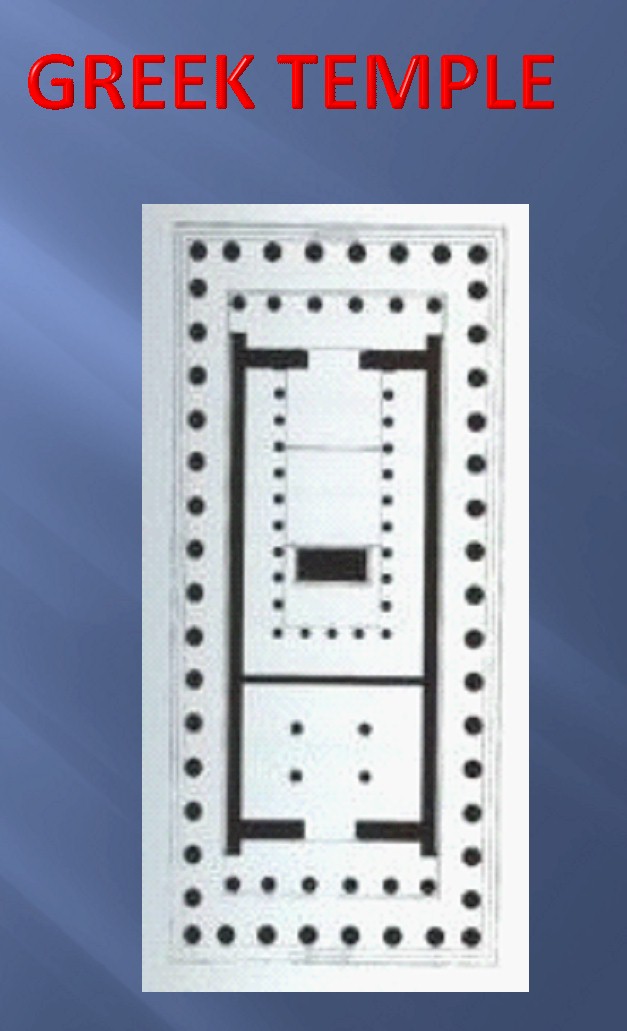
The
first Greek temples were made of wood. Stone
temples were built around 600 B.C. and were masonry versions of the timber
originals. The Greek Temples
consisted of the Cella, a plain
room-the seat of the god, which was normally left empty
except for an image, and a room at back designated as the treasury. Small
temples were fronted by a portico with four columns.
Larger temples were completely surrounded by a colonnade, which had no
function except to signal that this was a ceremonial and sacred building.
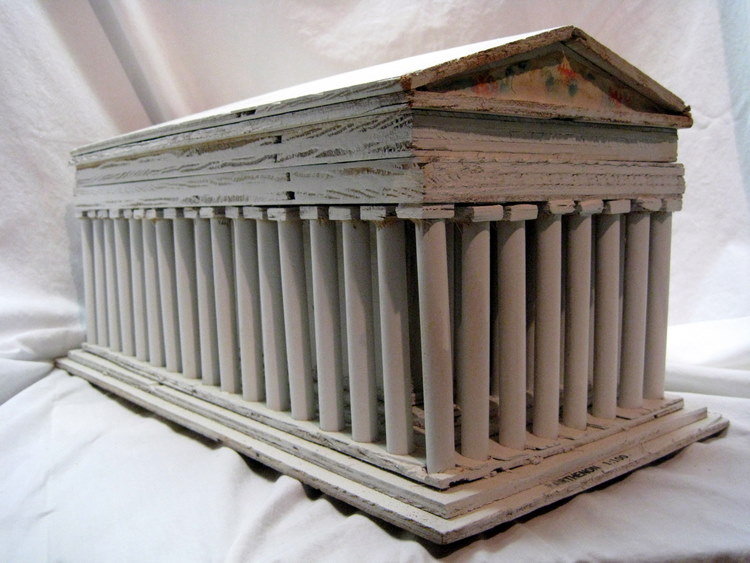
The
model (on the left) of the Parthenon was made by my son, Mark, for an 8th grade
project in 1980. The top comes off to reveal the interior. How many
of you reading this still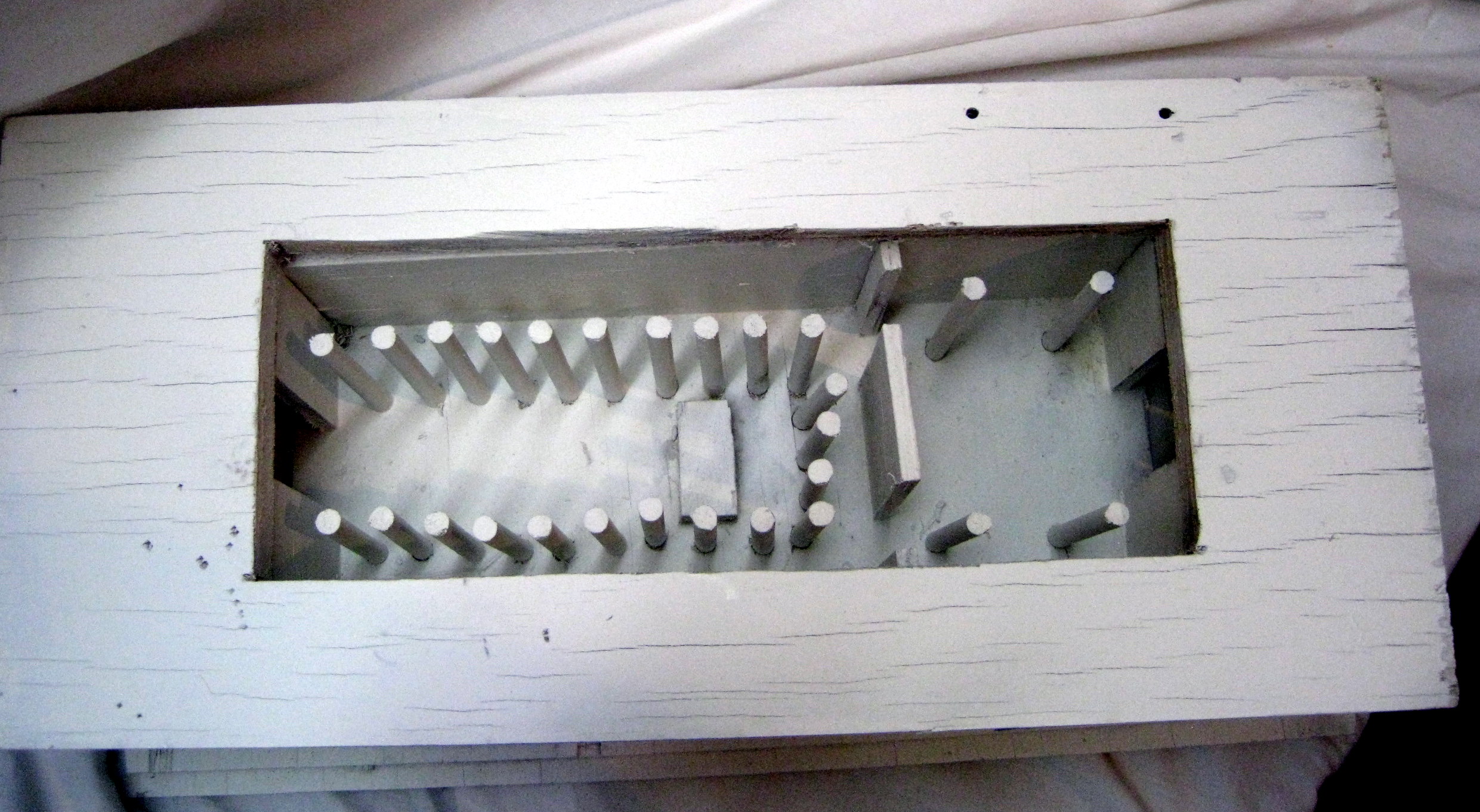
have your children's school projects from 30 years ago?

The Greek used three different styles of columns-
Doric, Ionic, and Corinthian. The
most obvious difference is the capitals. There are a number of sources available
where you can read about the difference.
ROMAN TEMPLES
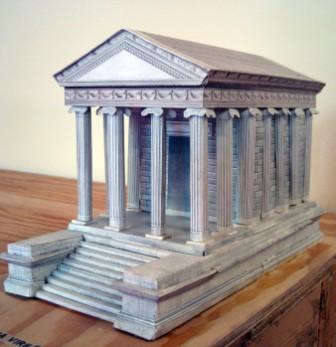
Roman temples were
not replicas of the Greek Temples. They
used Corinthian and Ionic columns, almost never Doric.
The temples were raised upon a podium approached by steps. They usually
had a portico with one or two columns deep at one end and often attached demi-columns
or half columns along the sides. A typical Roman Temple is which is well
preserved is Maison Carree at Nimes
in southern France. I made of the model of Maison Carree on the left.
CIRCULAR
TEMPLES
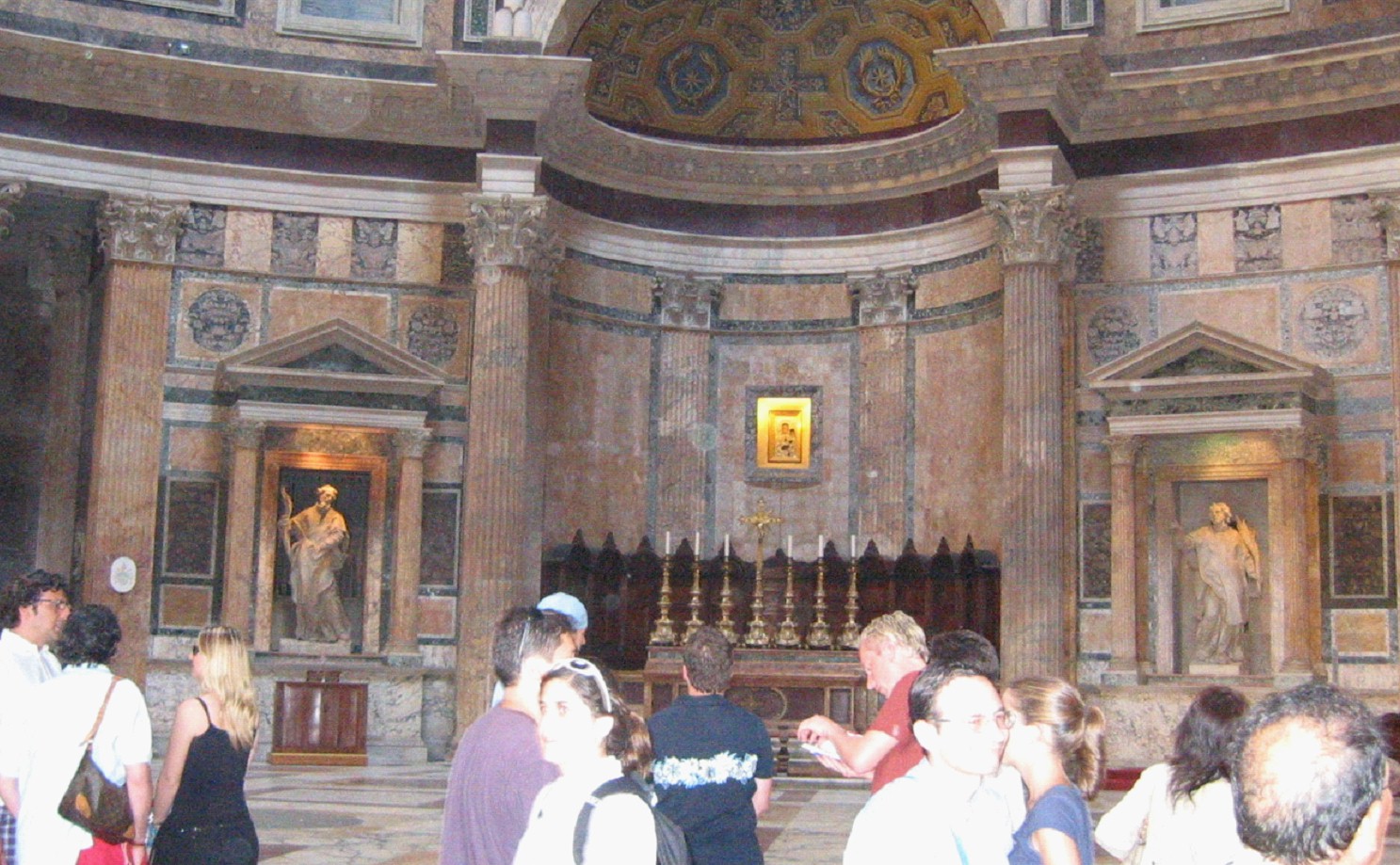
The Greeks did build
circular structures, but not temples. There
are Roman examples of circular temples. The
largest of the circular temples is the Pantheon in Rome.
It was dedicated to all the gods. The
interior was more important than the exterior as far as appearance is concerned.
It was made of brick and concrete which were new forms. The dome is a
spectacular architectural fete.
I will discuss the Pantheon when we visit on our “quest” of Italy in
2004.
THE
BASILICA
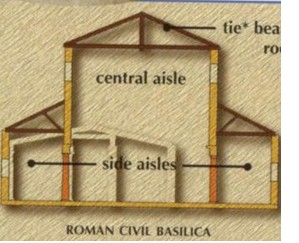
The name, basilica,
goes back to the royal hall of a king. Basilicas
were public assembly halls or law courts. They
consisted of a building with a
central nave flanked by aisles divided from the center by rows of columns.
The column supported wall that rose above aisle height, containing
windows (literally a ‘clear story’) and a wooden roof.
There was often an apse (a semi-circular vaulted extension at the east
end) where court was general held. This design which
we will look at in more detail became the architectural model for Christian
Churches throughout the period of the building of the great cathedrals rather
than the style of the Greek and Roman temples.
EARLY
CHRISTIANITY
It is not my purpose,
at this point, to write a history of Early Christianity.
There are thousands of sources that can enlighten you.
I simply want to say that the early Christians did not worship in
churches as we know them until the time of Constantine in the early 4th
century. During the first three
hundred years, Christians were subjected to persecution by a number of different
Emperors. Instead of church
buildings, many Christians worshipped in private homes or in the catacombs.
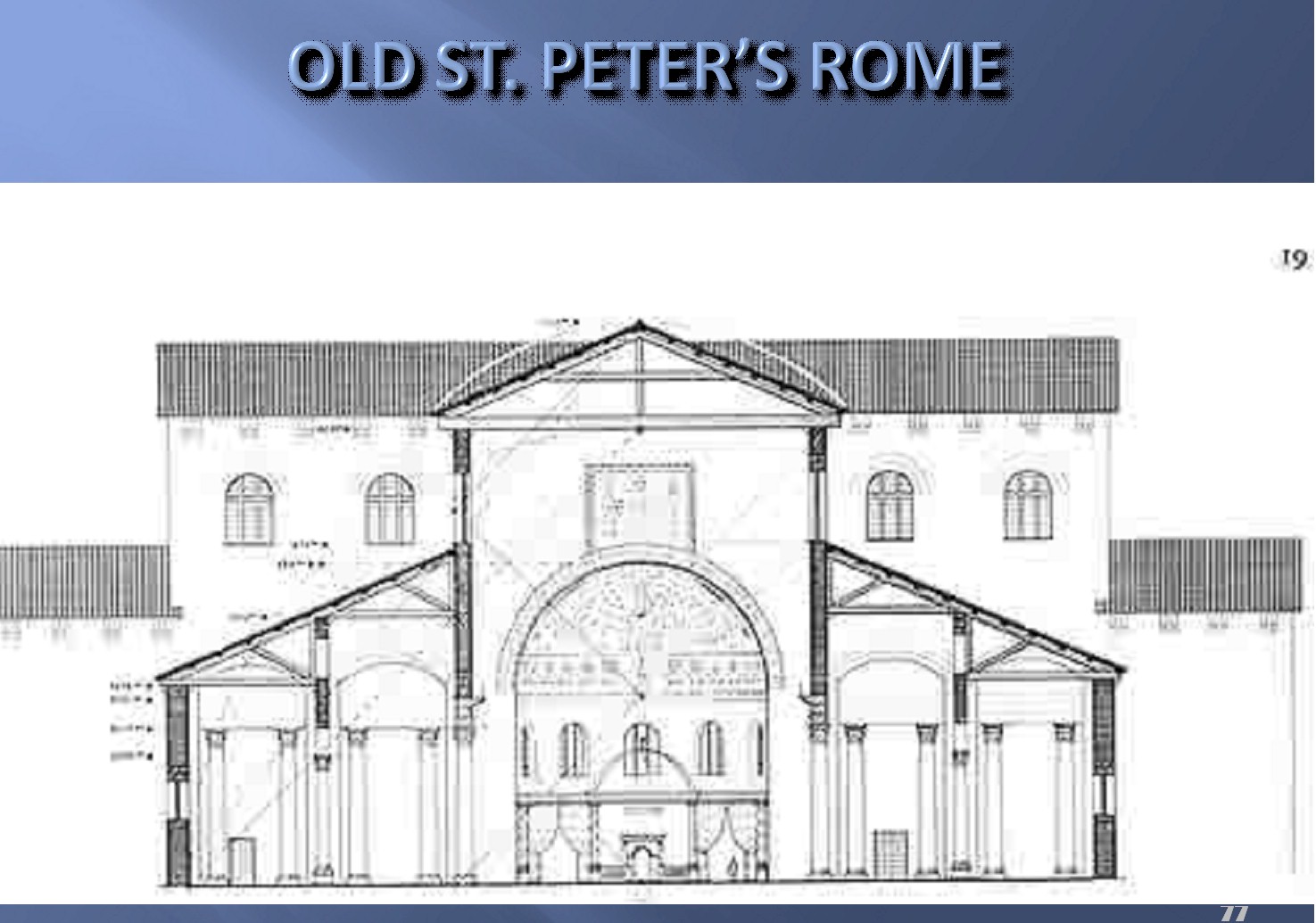
With the Edict of
Milan under Constantine, in 313, Christianity was recognized as a legal
religion. In 326 Christianity became the official religion of the Roman Empire.
Constantine immediately set in motion an ambitious program of church
building in Rome and the East. Between
326 and Constantine's death in 337 six major churches were begun: Old St. Peters, St. John
Lateran and S. Maria Maggiore all in Rome; Old St. Sophia in Constantinople;
Nativity in Bethlehem; and Holy Sepulchre in Jerusalem.
The reign of
Constantine marks the beginning of Christian architecture. Suddenly, without
previous experiment, a major new building type was invented.
Early
Christian churches did not follow design of the
classical Greek or Roman temple because the Christian church's use was different.
The need for blood sacrifices had been superseded by vicarious offering
of Christ himself, and churches were intended primarily as meeting places where
the faithful could celebrate the Holy Eucharist.
ROMANESQUE CHURCH DESIGN
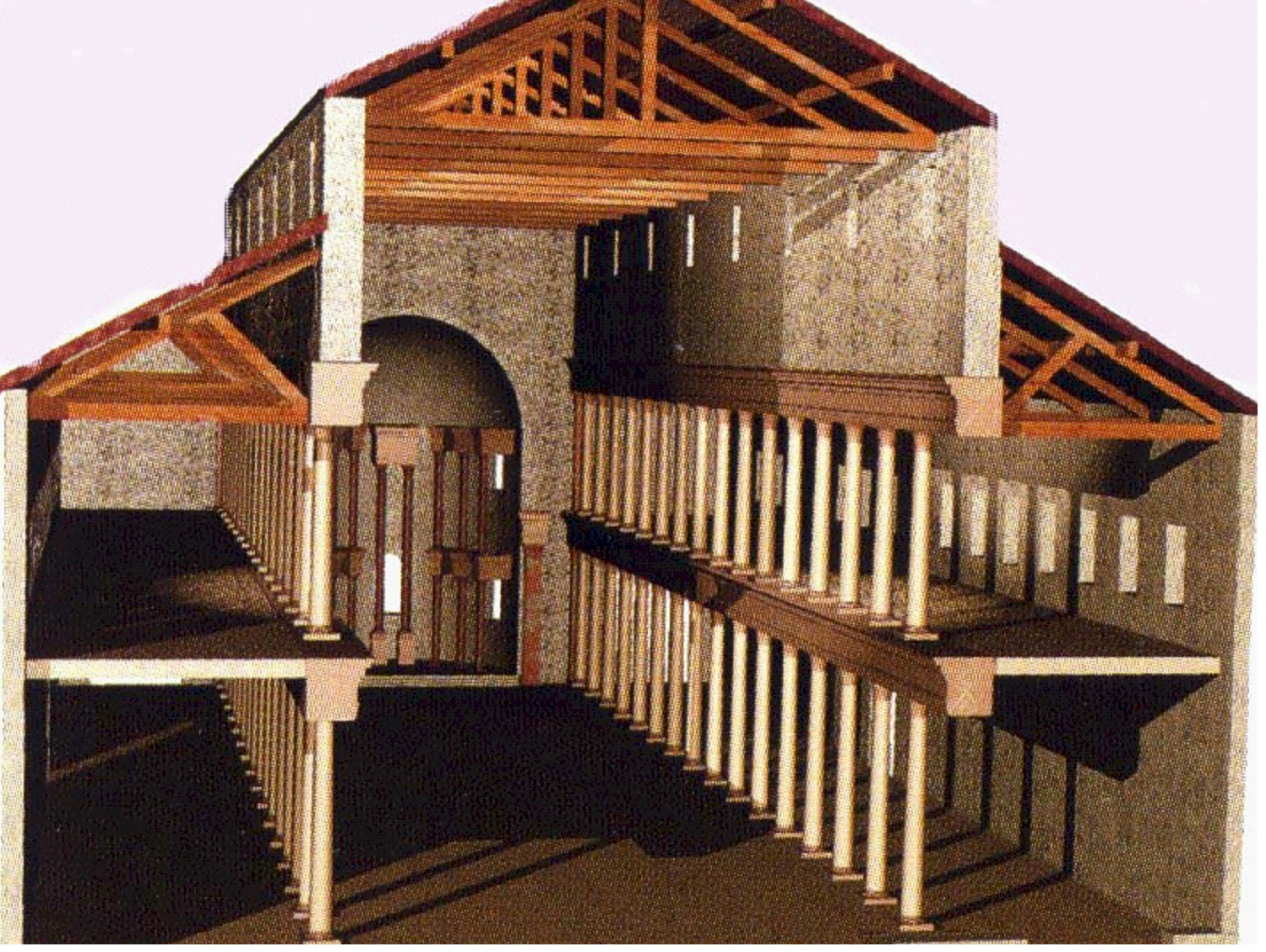 The standard design
was that of the Roman basilica-the meeting hall. The basilica consisted of a two
story structure that could measure up to 65 ft wide.
To this was added one or two story side aisle on each side. The building was
very wide and the clerestory windows at the top of the nave
or middle section provided sufficient light for the entire building.
The standard design
was that of the Roman basilica-the meeting hall. The basilica consisted of a two
story structure that could measure up to 65 ft wide.
To this was added one or two story side aisle on each side. The building was
very wide and the clerestory windows at the top of the nave
or middle section provided sufficient light for the entire building.
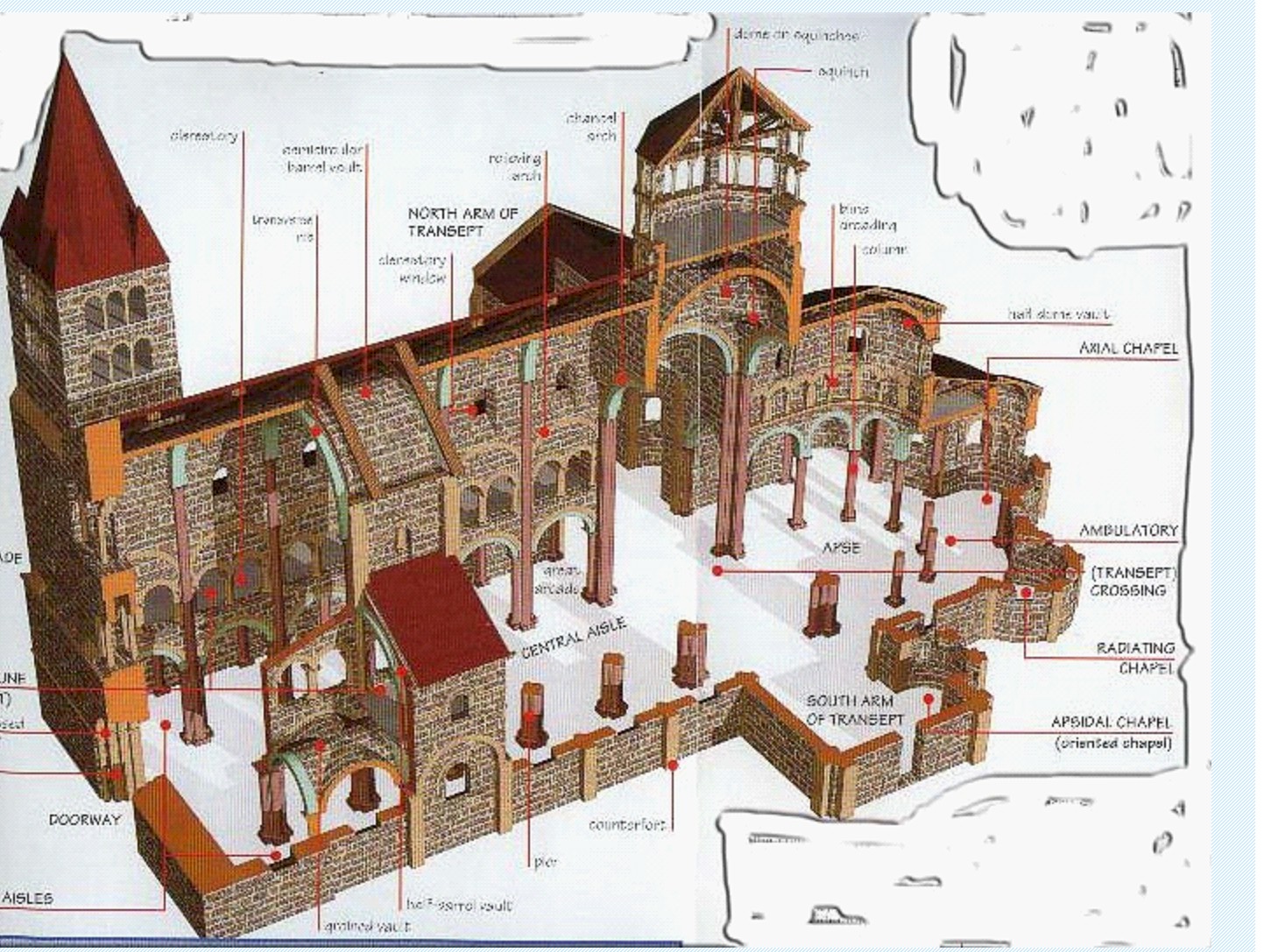
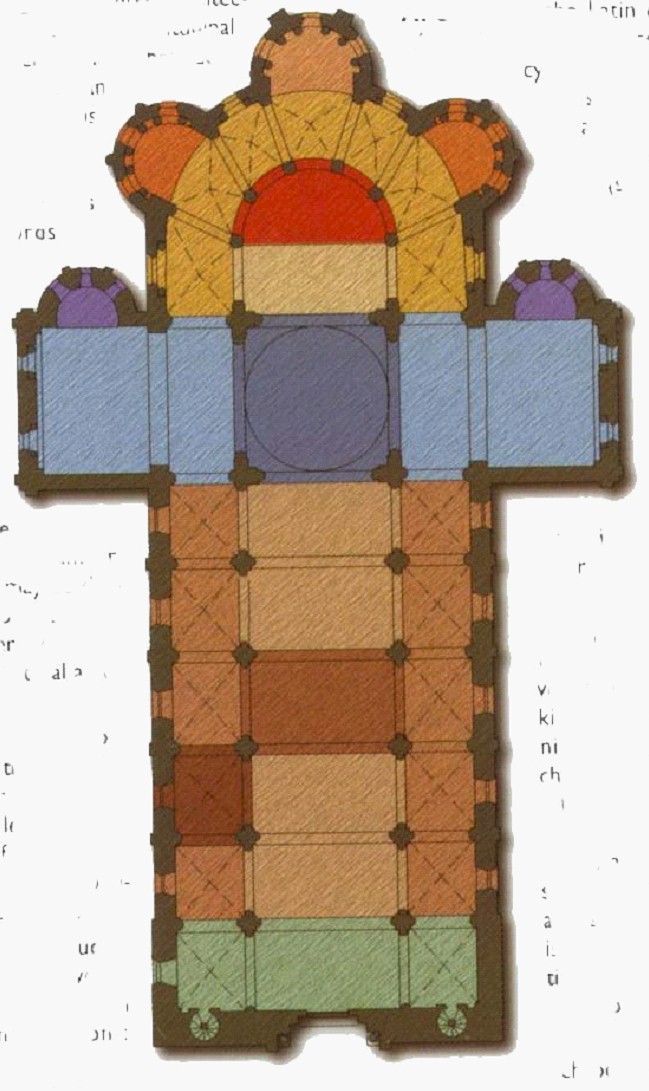
Often side arms,
called transepts, were added on either side of the nave to accommodate the
great number of people who came to worship.
These additions gave the churches a Latin Cross floor plan. The apse or the east end was the place of the court in the Roman
basilica. In the new church it
became the holy of holies- the sanctuary- the place of the altar. Between the
apse and the nave was an area known as the chancel or choir.
In the earliest days, the clergy, known as the cathedral chapter,
occupied this space for worship. With
the advent of popularity of relics, a means of “crowd control” was needed so
the area in the apse behind the altar became known as the ambulatory.
Often small altars or chapels were constructed in the ambulatory. The
chapels generally contained a relic. Worshipper
would enter one side and “amble” around the apse to venerate these relics
and exit on the other side. Tall towers were added to the exterior.
Often their was a pair on either side of the front -West Facade. There
were also towers build over the great cross - the point where the nave, the transepts
and the chancel met.

RELICS
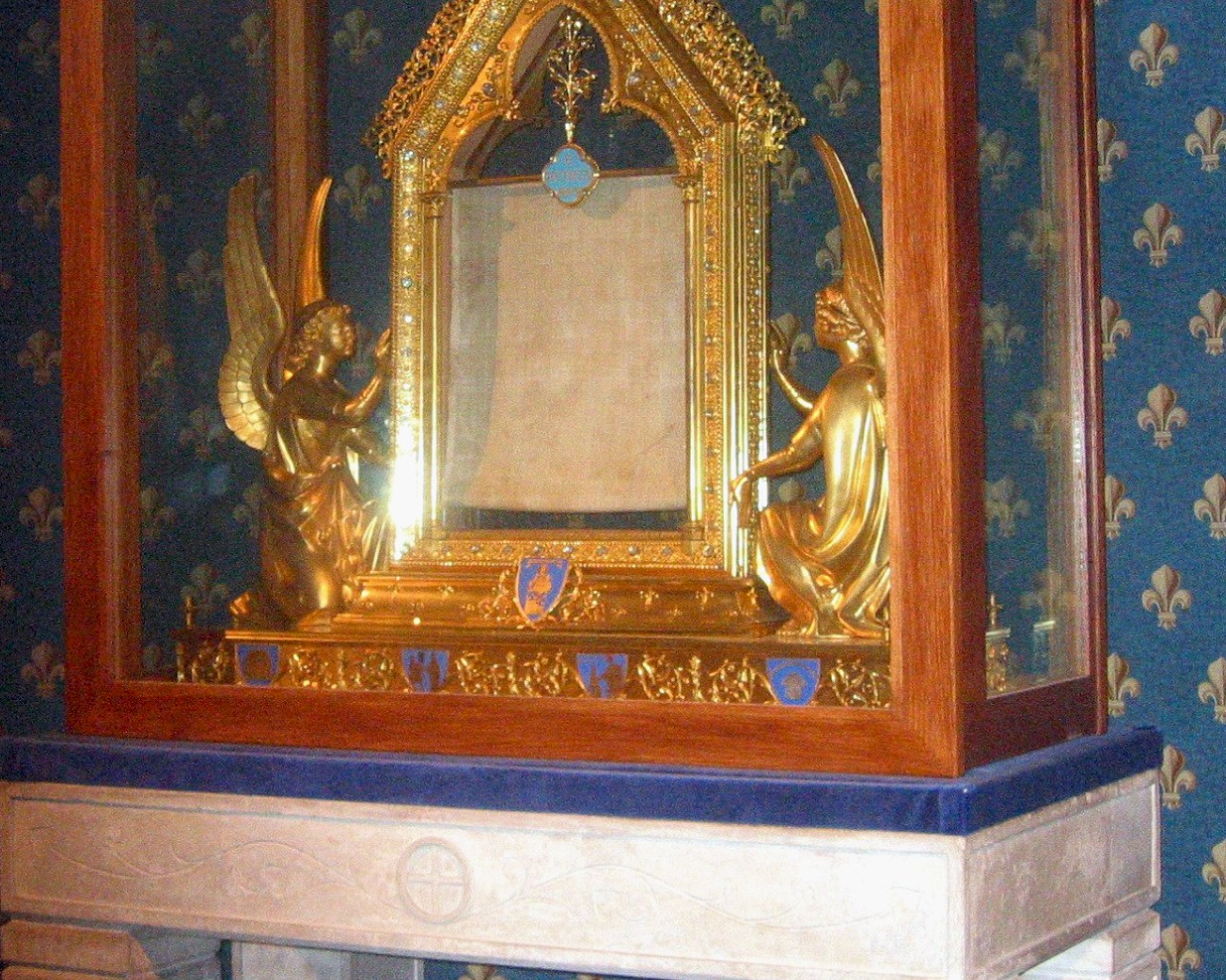
Relics become very important in
the early Middle Ages and in some respect are still important to many
Christians. During the early days of
Christianity many people were persecuted or put to death for their belief.
These martyrs became venerated. In
326, St. Helena , mother of Constantine, is said to have visited the holy land,
and afterwards the imperial commissioner began to identify the holy places and
to supervise the construction of basilicas in each of them. There were over
two hundred churches constructed in this period in Palestine. Every
altar needed the relics of a saint to act as its sacred guarantor of
consecration. Until the 10th century the body had to be intact. Later
bones and other body parts of those who were martyred became holy objects and
were said to possess healing properties and ability to work miracles. Other
objects such as a part of the clothing of saints were venerated. In
a sense, it became a popularity contest – which church or individual had parts
of the most famous saint. Small bones, finger nails, hair of the martyred were
in great demand. Human nature being
what it is, selling of “non- martyred” bones became a great scam. I guess
much of this could have been avoided if they had had DNA.
I recently read a medieval mystery where a few hairs from the beard of
some obscure saint became the source of conflict between two rival churches.
Christians would go on pilgrimages to visit these famous relics.
Many churches were named for particular saints whose bones reside there.
There was generally an “admission charge” for the pilgrims. The more famous
the saint, the larger the income which enabled the congregations to build bigger
churches.
THE
ADVENT OF MONASTICISM
The conversion of
Constantine and the end of imperial persecution of Christians necessitated a change in
Christian heroism. Under
Constantine’s rule was almost impossible to get oneself martyred. With
martyrdom no longer readily available, dedicated Christians eager to excel in
their faith, abandoned the world and lived lives of great austerity. Their lives
were dedicated to seclusion, prayer, self denial and spiritual contemplation.
Monasticism began in Egypt around the start of the 4th c.
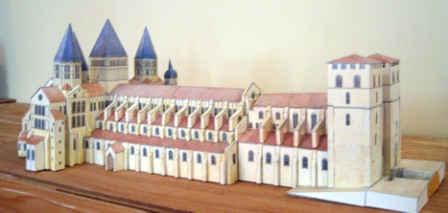
During the Middle
Ages, monks became members of various orders: the Benedictines, Franciscans,
Cistercians, Carthusians, and Dominicans.
These orders began to build
monasteries. Many faithful
Christians felt the call to join one of the orders and to live in seclusion in a
monastery. Monasteries began
to crop up all over the Roman Empire. One
of the most famous was Cluny which was founded in 910.
By the 14th century, 825 monasteries owed their allegiance to
Cluny (model of Cluny on the right). As monasticism spread so did
the need for more and more church buildings or abbeys. There is an abundance of
literature about the various orders.
THE FALL OF THE ROMAN EMPIRE
Though
Germanic peoples had been pushing against the borders of the Roman Empire for
centuries, they did not became an acute threat until the 4th
century. Rome had been weakened by military usurpers and unqualified
leaders for some time causing emperor Diocletian to split the empire in 286 into
two distinct units - East and West. In 330 Constantine moved the capital to
Constantinople. It became the new Rome. Old Rome and the
Western Empire were left in the hands of corrupt and inadequate administrators,
managing under trained and under paid soldiers.
In
370, Huns rode out of the East. They were skilled archers who could move
in tandem in cavalry maneuvers for which the Romans were completely
unprepared. From the north came the Vandals, who pushed into Gaul. Finally
the Goths took Rome in 410. In 476 a German chieftain, Odoacer, deposed
the last Western Emperor and proclaimed himself king. There many
interesting books written on the Fall of the Roman Empire. There are
countless reasons for this decline. Somewhere I obtained a list of 210
reasons for the Fall of the Roman Empire!!!
THE
EARLY MIDDLE AGES - THE RISE OF THE PAPACY
After
the Fall of the Roman Empire, the Bishop of Rome, better known as the Pope had
no rival patriarchs. The church in Rome was the only church in the West to
claim to have been founded by an Apostle - Peter. Since Constantine
had moved to the East, the Pope became the recognized head of the church.
During the invasions of the various tribes, the Church was the one institution
that was strong enough to resist the invaders and even win their respect.
The Franks converted to Christianity, which started with the baptism of Clovis
in 496 and 3000 of his followers.
Another
important person was Gregory the Great, a Benedictine monk, who was elected Pope
in 590. It was Gregory who sent Augustine to Canterbury. Among the
next important persons in the growth of the church was Charlemagne who
became Emperor of the Holy Roman Empire in 800. It was at this point that the
question arose as to who had the final authority - the Pope or the Emperor. This
conflict was really never settled. It all depended on who was stronger at the
time.
We
don't know too much about the Romanesque churches during the Early Middle
Ages. Most buildings did not withstand a long history. Except for
two of the churches that Constantine built, they had been destroyed or replace
including Old St. Peter's.
So
by the year 1000 a find a great boom in church building. Congregations
quickly outgrew their facilities. Most of the churches that survived the
Early Middle Ages had be replaced. Many had been destroyed by the
invaders, some fell down and other burned.
THE
FAILING AND FALLING OF ROMANESQUE CHURCHES
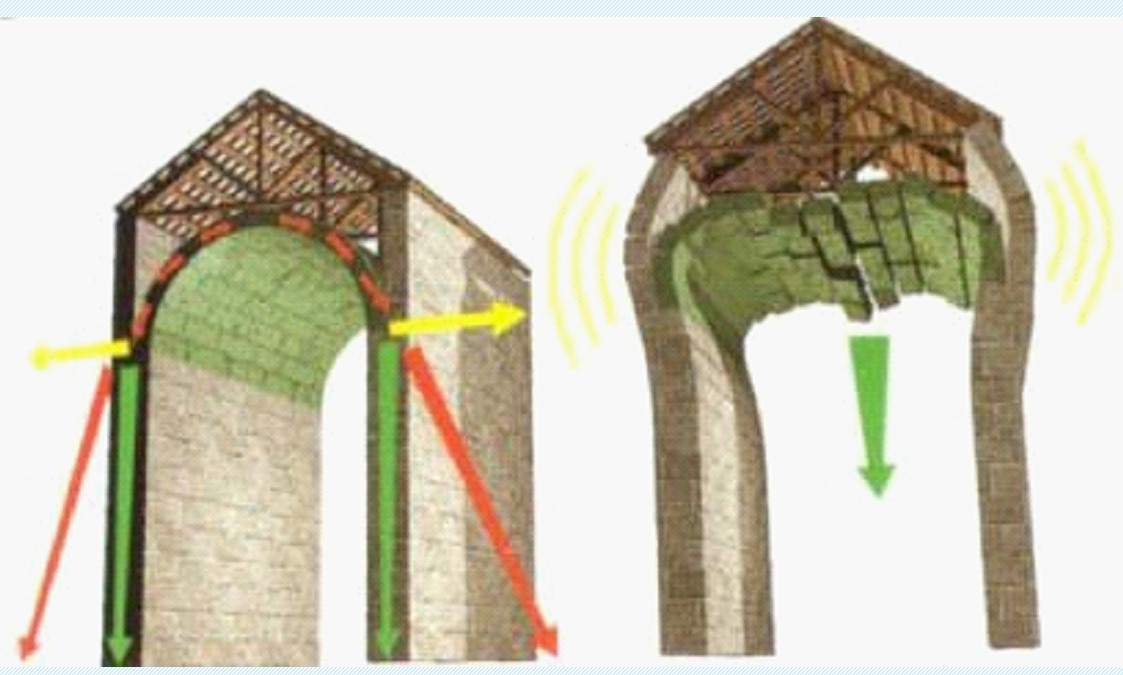
The Romanesque style
of church had many failures. They
were rather dark on the inside because the high walls would not support large
openings for windows. The wall were very thick. The arches were rounded and as such would not
tolerate a
lot of weight without crumbling. There was the need for larger and larger
churches by the time of Charlemagne. The influence of the papacy resulted in
more and more people being converted to Christianity. The traffic of those
wanting to honor relics increased. Many Christians went on pilgrimages.
Cathedrals became the center of activity of the community. The main problem with these large Romanesque churches was that they kept
falling down. In the illustration above,
notice how the stress on the walls push them out causing the ceiling to fall and
the walls to crumble. I would highly
recommend Ken Follett’s book, "Pillars of the Earth" as an interesting and
enjoyable read on the demise of the Romanesque structure and the birth of
Gothic. Not only did many Romanesque churches fall down, they also burned
down. They had timber roofs which were often struck by lightening or in
some cases they burned along with other buildings in the community when there
was a major fire. It was only a little over a hundred years from the beginning of the
Romanesque style until many of the architectural problems were solved and corrected as
Abbot Sugar began his remodeling of St. Denis in Paris in 1140. He became the
father of Gothic architecture which will be discussed on another page.
There
are very few surviving original Romanesque churches. The list below names those
churches which can be classified Romanesque because they were begun between 1000
and 1200. Most of them were added to or sections rebuilt when they were damaged
by fire or in war. The World Wars severely damaged many European
cathedrals and churches. Most of them have been rebuilt, and thus rebuilt
with more modern materials. As repairs and enlargements of the Romanesque
churches took place, they adopted Gothic and later period characteristics.
As we go on our quest we will visit cathedrals and churches where part of the
exterior is Romanesque with Gothic flying buttresses and Baroque altar pieces.
Below
is a list of the Romanesque churches that we have visited.
As I write about these churches on the various travel pages, I will
provide a link from the church listed below to a full description of that
particular church.
Present
Finish
City
Country
Church Name
started
Date
326
Trier
Germany
Cathedral
330
Trier
Germany
Basilica
526
Ravenna
Italy
San Vitale
549
Classe (Ravenna)
Italy
Sant Apollinare in Classe
561
Ravenna
Italy
Sant Apollinare
Nuvov
800
Aachen
Germany
Cathedral
900
Venice
Italy
St. Felice
935
Sieci
Italy
S.
Giovanni Battista a Renole
974
1220
Cologne
Germany
St. Andreas
975
Mainz
Germany
St. Martin's Cathedral
1000
Lindau
Germany
St. Peters
1005
1034
Reims
France
St. Remi
1008
Torcello -Venice
Italy
Cathedral of Sant Maria
Assurto
1011
Torcello -Venice
Italy
Santa Fosca
1012
1095
Como
Italy
Sant Abbondio
1019
Basel
Switzerland
Munster
1025
Speyer
Germany
Imperial Cathedral
1028
Fiesole
Italy
Cathedral - San Romolo
1035
1084
Mont St. Michel
France
Mont St. Michel
1040
1067
Jumieges
France
Jumieges
1042
Como
Italy
San Fedele
1043
1073
Venice
Italy
St. Mark's Basilica
1049
Cologne
Germany
St. Maria im Kapitol
1050
Paris
France
St. Severin
1060
1065
Caen
France
St.
Trinite'
1060
1065
Caen
France
St. Etienne
1063
1170
Pisa
Italy
Cathedral
1100
Cologne
Germany
St. Gereon
1100
Zurich
Switzerland
Gross munster
1125
Worms
Germany
Dom St. Peter
ROMANESQUE/
GOTHIC /
RENAISSANCE
/BAROQUE / CHURCH
INDEX



The Romanesque style
of church had many failures. They
were rather dark on the inside because the high walls would not support large
openings for windows. The wall were very thick. The arches were rounded and as such would not
tolerate a
lot of weight without crumbling. There was the need for larger and larger
churches by the time of Charlemagne. The influence of the papacy resulted in
more and more people being converted to Christianity. The traffic of those
wanting to honor relics increased. Many Christians went on pilgrimages.
Cathedrals became the center of activity of the community. The main problem with these large Romanesque churches was that they kept
falling down. In the illustration above,
notice how the stress on the walls push them out causing the ceiling to fall and
the walls to crumble. I would highly
recommend Ken Follett’s book, "Pillars of the Earth" as an interesting and
enjoyable read on the demise of the Romanesque structure and the birth of
Gothic. Not only did many Romanesque churches fall down, they also burned
down. They had timber roofs which were often struck by lightening or in
some cases they burned along with other buildings in the community when there
was a major fire. It was only a little over a hundred years from the beginning of the
Romanesque style until many of the architectural problems were solved and corrected as
Abbot Sugar began his remodeling of St. Denis in Paris in 1140. He became the
father of Gothic architecture which will be discussed on another page.
|

